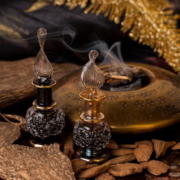The 7 olfactory families
Olfactory families represent an essential classification in perfumery, used to subdivide fragrances according to their main aromatic characteristics. These families have evolved over time, and although their origin dates back to the early 20th century, they remain a fundamental tool for understanding and describing a fragrance. Today, seven traditional olfactory families are identified, each with its own peculiarities and unique artistic expression. However, new categories, such as gourmand and marine fragrances, have emerged in recent years, pushing the boundaries of traditional classifications.
The seven traditional olfactory families
- Citrus (or Esperidata)
Citrus fragrances are fresh, crisp, and light, characterized by the use of citrus essential oils such as orange, lemon, bergamot, and tangerine. This family is especially popular in summer perfumes and eau de colognes because of its energizing freshness.
Example: Eau de Cologne by 4711, one of the oldest colognes in the world, perfectly embodies the fresh and bright spirit of citrus notes. - Floral
The floral family is the largest and includes fragrances dominated by floral notes such as rose, jasmine, iris, ylang-ylang, and orange blossom. Floral fragrances can be soliflore (dominated by a single flower) or bouquet (a combination of flowers).
Example: J’adore by Dior, an iconic fragrance that expresses a refined bouquet of flowers, with the predominant presence of jasmine and rose. - Fougère
The fougère (from the French “fern”) family is one of the most structured, born from a base of lavender, bergamot, and geranium notes combined with oakmoss, wood, and coumarin. Fougères are typically masculine and convey a timeless, classic elegance.
Example: Houbigant’s Fougère Royale, considered the first fougère perfume, created in 1882, is the quintessence of this family. - Chypre
Chypre (from the French “Cyprus”) fragrances have a complex structure, combining notes of citrus (usually bergamot) with a heart of flowers and a base of oakmoss, patchouli and labdanum. The chypre family is elegant, sophisticated and usually very persistent.
Example: Mitsouko by Guerlain, one of the most celebrated chypre perfumes, with its balanced combination of fruits and spices on a musky base. - Woody
Woody fragrances are characterized by the use of notes such as sandalwood, cedar, patchouli, and vetiver. These ingredients result in fragrances that are warm, enveloping and often very sensual. The woody family is present in both men’s and women’s perfumes.
Example: Terre d’Hermès, a perfume that enhances the woody notes of vetiver and cedar while maintaining a refined elegance. - Amber (Oriental)
The amber family (also known as oriental) includes warm, sensual fragrances enriched with notes of vanilla, spices, resins, and balsams. Oriental fragrances evoke mystery and intensity, with a strong presence of sweet and spicy notes.
Example: Shalimar by Guerlain, a classic oriental that combines vanilla, frankincense, and bergamot, creating a luxurious and opulent fragrance. - Cuoiata
Cuoiata fragrances are characterized by notes reminiscent of leather, such as burnt wood, tobacco, and birch. They are typically intense and smoky, with a bold and distinctive appeal.
Example: Cuir de Russie by Chanel, a scent that evokes the elegance and sensuality of leather, with a delicate fusion of flowers and spices.
The evolution of olfactory families: new trends
In recent years, the world of perfumery has seen the emergence of new olfactory families that push the boundaries of traditional categories. Among these, two of the most prominent are:
- Gourmand: This category, not yet officially recognized, is characterized by fragrances that evoke sweet and “edible” notes, such as chocolate, caramel, cotton candy, and vanilla. Gourmand fragrances are warm and inviting, often irresistible.
Example: Angel by Thierry Mugler, a fragrance pioneering the gourmand genre, with notes of chocolate and caramel. - Marine: This family is also new to the olfactory scene. Marine perfumes evoke the smell of the ocean, thanks to the use of synthetic molecules that mimic aquatic and brackish notes.
Example: Acqua di Giò by Giorgio Armani, a fragrance that brought the concept of marine freshness to the forefront and became an icon in the category.
Conclusion
Traditional olfactory families offer a valuable guide to understanding the wide range of scents available, allowing one to explore different olfactory nuances and find fragrances that reflect one’s style and personality. With the advent of new trends such as gourmand and marine scents, perfumery continues to evolve, pushing creativity and innovation to new levels. However, the seven classic families remain fundamental to describing and classifying the timeless art of perfume.






